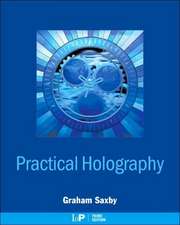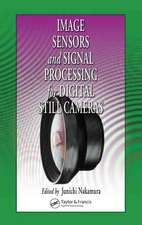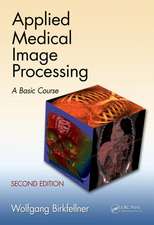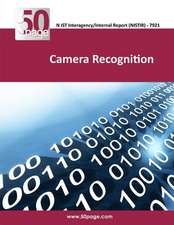The Science of Imaging
Autor Graham Saxbyen Limba Engleză Hardback – 19 noi 2010
Improvements to this Edition Include:
- A new chapter on astronomical imaging
- A larger format with a wealth of illustrations
- Major revisions in the areas of digital imaging and modern technology
- Updated references with links to a wealth of online resources—including teaching material and expanded information
Praise for the critically acclaimed First Edition:
It's the best book I have read on the subject at this level.
—Ron Graham, RPS Journal
... every student should read it, every photographer should own it, and every lecturer and journalist should know its contents inside out.
—Jon Tarrant, British Journal of Photography
| Toate formatele și edițiile | Preț | Express |
|---|---|---|
| Paperback (1) | 269.34 lei 6-8 săpt. | |
| CRC Press – 30 sep 2020 | 269.34 lei 6-8 săpt. | |
| Hardback (1) | 491.01 lei 6-8 săpt. | |
| CRC Press – 19 noi 2010 | 491.01 lei 6-8 săpt. |
Preț: 491.01 lei
Preț vechi: 736.03 lei
-33% Nou
Puncte Express: 737
Preț estimativ în valută:
93.96€ • 98.80$ • 77.63£
93.96€ • 98.80$ • 77.63£
Carte tipărită la comandă
Livrare economică 17 aprilie-01 mai
Preluare comenzi: 021 569.72.76
Specificații
ISBN-13: 9781439812860
ISBN-10: 1439812861
Pagini: 368
Ilustrații: 305 black & white illustrations, 30 colour illustrations, 1 black & white tables
Dimensiuni: 210 x 280 x 23 mm
Greutate: 1.08 kg
Ediția:Revizuită
Editura: CRC Press
Colecția CRC Press
ISBN-10: 1439812861
Pagini: 368
Ilustrații: 305 black & white illustrations, 30 colour illustrations, 1 black & white tables
Dimensiuni: 210 x 280 x 23 mm
Greutate: 1.08 kg
Ediția:Revizuită
Editura: CRC Press
Colecția CRC Press
Public țintă
UndergraduateCuprins
The Nature of Light. Photometry, Lighting, and Light Filters. Visual Perception. Lens Principles. Types of Lenses. Resolution in Optical Systems. Images in Color. Still Cameras. Motion and High-Speed Photography. The Silver Halide Process. Digital Recording of Images. Halftone, Electrostatic, and Digital Printing. Television. Video Recording and Replay Systems. Three-Dimensional Imaging. Holography. Astronomical Imaging. Macrography, Micrography, and Microimaging. Imaging the Invisible. Appendix 1: Logarithms: What They Are, What They Do. Appendix 2: How a Hologram Works. Appendix 3: The Fourier Model for Image Formation. Appendix 4: The Meaning of pH.
Notă biografică
Graham Saxby served in the Royal Air Force (RAF) for 27 years, the first 19 in the trade of photographer, where he undertook almost every possible form of assignment. After being commissioned into the Education Branch, he was Officer Commanding Photographic Science Flight at the RAF School of Photography at Cosford for seven years. On leaving the RAF he joined the staff of what is now the University of Wolverhampton as Senior Lecturer in Educational Technology, later moving to the Department of Applied Sciences to teach modern optics. His research into display holographic techniques has earned him an international reputation, and his books have won several prestigious awards. Currently, he works as a freelance editor and reviewer of technical books and as a consultant in optical and photographic matters. He is a Fellow of the Institute of Physics and an Honorary Fellow of the Royal Photographic Society.
Recenzii
In summary, the book has many useful formulas for a variety of designs. It is well organized, so users can easily find the section relevant to their needs. And the plethora of worked examples is very helpful. … I see it as a useful introduction to the clinical researcher and as a reference for the statistician interested in sample size formulae for specific designs.
—The International Biometric Society, 2012
Graham Saxby proves to us in his brilliantly written and well-structured book that many essential topics of such a broad and comprehensive field can be squeezed into 352 pages. In my opinion, anyone having an interest on current imaging technologies should read it to extend their knowledge or to develop a broad vision on the field. … it is definitely suitable as a complementary textbook for undergraduate courses on imaging and optical technologies. It can as well be used as a reference book for any interested reader to learn the specific terminology in the field. … The explanations are extremely informative and easy to follow. In addition, the text is backed up with many excellent illustrations and intriguing real life examples that I think many lecturers would want to make use of them in their lectures.
—Doga Gürsoy, Contemporary Physics, 2011
I recommend this book for its clear and readable style of a wide-ranging subject. … buy this book for an easy-to read holistic account of scientific imaging …
—Jeremy Sanderson, Blo-Imaging Facility, MRC, Harwell, UK, INFOCUS, 2011
Praise for the First Edition:
... a truly valuable book, magnificently bringing together such diverse technologies, yet keeping a practical eye on who is likely to be reading it. It's the best book I have read on the subject at this level.
—Ron Graham, RPS Journal
... well written ... lots of helpful marginal notes …if your research depends on obtaining and analysing top-quality images, this boo
—The International Biometric Society, 2012
Graham Saxby proves to us in his brilliantly written and well-structured book that many essential topics of such a broad and comprehensive field can be squeezed into 352 pages. In my opinion, anyone having an interest on current imaging technologies should read it to extend their knowledge or to develop a broad vision on the field. … it is definitely suitable as a complementary textbook for undergraduate courses on imaging and optical technologies. It can as well be used as a reference book for any interested reader to learn the specific terminology in the field. … The explanations are extremely informative and easy to follow. In addition, the text is backed up with many excellent illustrations and intriguing real life examples that I think many lecturers would want to make use of them in their lectures.
—Doga Gürsoy, Contemporary Physics, 2011
I recommend this book for its clear and readable style of a wide-ranging subject. … buy this book for an easy-to read holistic account of scientific imaging …
—Jeremy Sanderson, Blo-Imaging Facility, MRC, Harwell, UK, INFOCUS, 2011
Praise for the First Edition:
... a truly valuable book, magnificently bringing together such diverse technologies, yet keeping a practical eye on who is likely to be reading it. It's the best book I have read on the subject at this level.
—Ron Graham, RPS Journal
... well written ... lots of helpful marginal notes …if your research depends on obtaining and analysing top-quality images, this boo
Descriere
Updated and expanded to keep pace with the digital revolution, the new edition of this critically acclaimed work provides a comprehensive exploration of imaging science. Extensively illustrated, the second edition covers the fundamental laws of physics as well as the cutting-edge techniques defining current and future directions in the field. This accessible introduction takes readers on a grand tour of imaging. Starting with the fundamentals of light and basic cameras, the author journeys through television and holography to advanced scientific and medical imaging. He highlights essential formulas, while keeping the complex mathematics to a minimum.






















